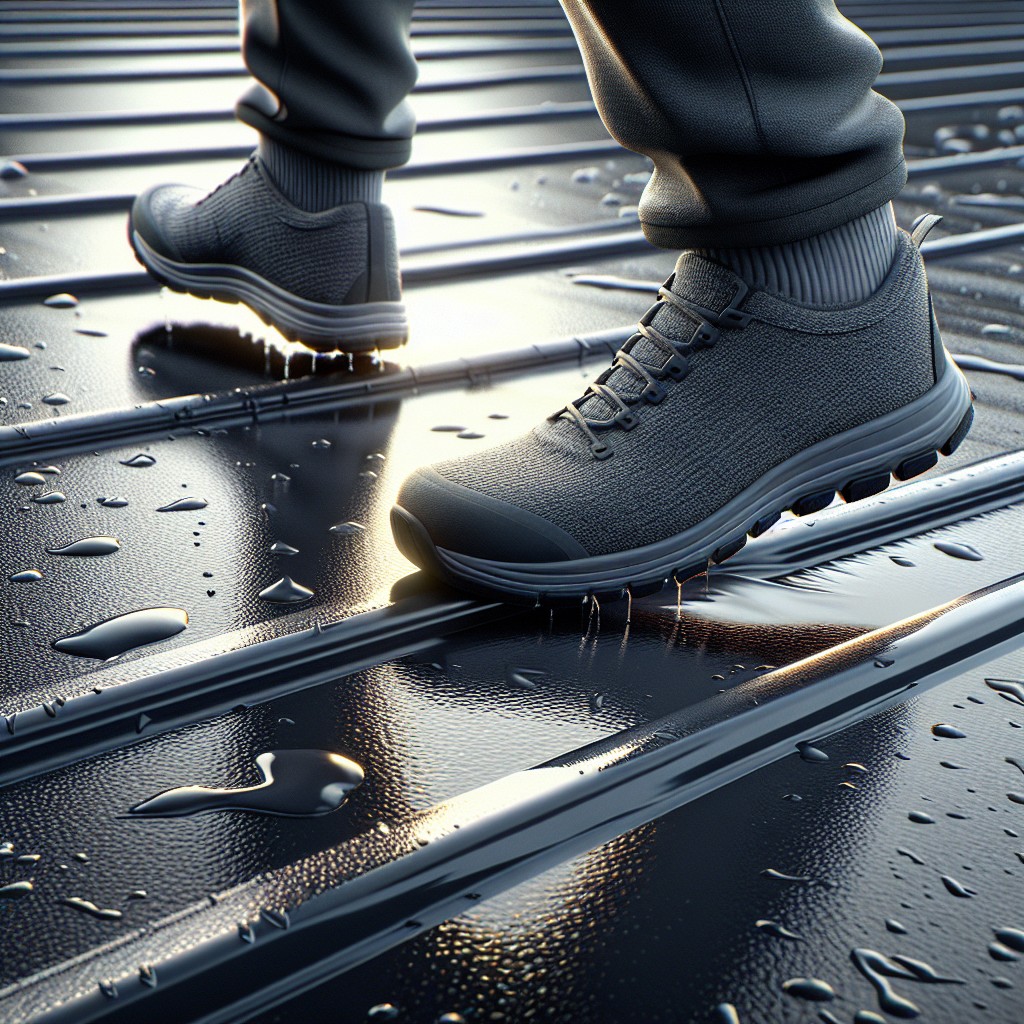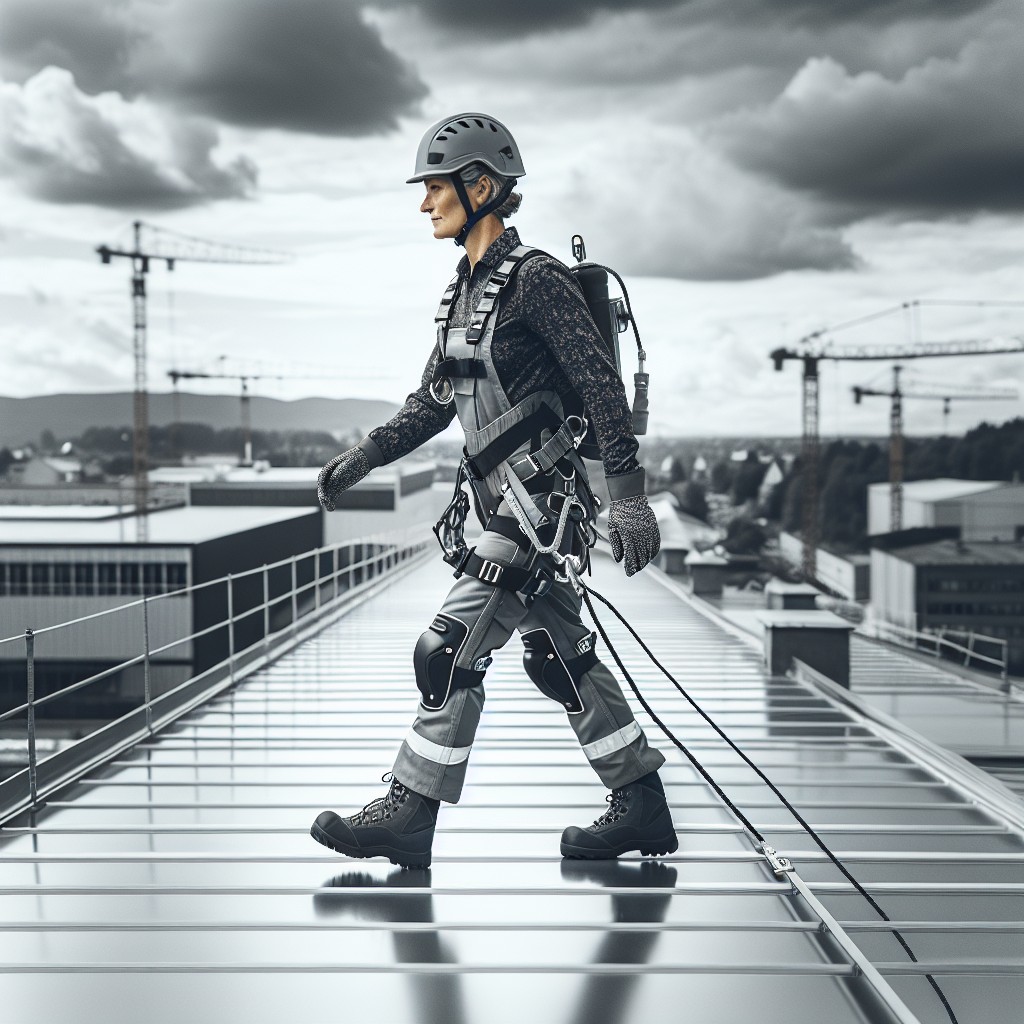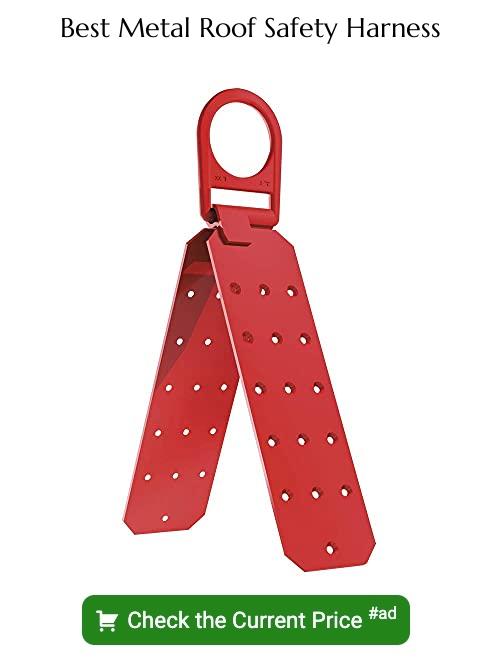Last updated on
Learn tested methods to prevent slipping on a metal roof, because mastering these techniques could save you from potentially hazardous situations.
Key takeaways:
- Choose proper footwear with rubber soles for maximum grip
- Walk along seams on metal roof for extra support
- Plan your route to minimize movement and avoid hazards
- Use a roof ladder and roof jacks for stability
- Take small steps and avoid walking on wet or icy surfaces
Choose the Right Footwear For Walking On Metal Roof

Selecting appropriate footwear is paramount for safety on a metal roof. Opt for shoes with soft, non-slip rubber soles to ensure maximum grip. Shoes specifically designed for roofing or traction-enhanced work boots are recommended.
The tread pattern is equally important: Look for designs that facilitate stability and prevent debris buildup, which can compromise footing. Avoid leather-soled shoes or those with minimal tread. Footwear should also be comfortable and provide ample support to the foot, reducing the risk of fatigue during long periods of work.
Always check the condition of your shoes before ascending a metal roof; worn soles can significantly decrease traction.
Best Technique To Walk On A Metal Roof

Walking on a metal roof requires a specific method to maintain balance and avoid falls. It’s advisable to walk along the seams where the panels join, as this area often has extra support. Ensure your body weight is evenly distributed and your center of gravity is low.
Proceed with deliberate, controlled steps, as though you are climbing a ladder – the heel of your foot should make contact first, followed by the rest of your foot. When possible, move perpendicular to the ribs of the metal panels, which can help provide better footing. Remember to keep your pace steady and avoid sudden movements that could cause you to slip.
Plan Your Route
Before ascending a metal roof, it’s crucial to visualize and determine the path you’ll follow. This approach minimizes the frequency and extent of movement, thus reducing the risk of slips.
- Identify the ridge, hips, and valleys, as these areas offer more stability.
- Consider the placement of skylights, vents, and other installations to ensure you maintain a safe distance.
- Keep in mind the location of your tools and materials to create a streamlined workflow.
- If repairs are needed, choose the most direct path to the repair site to limit unnecessary movement.
- Take note of any potential hazards like power lines or tree branches that could impact your route.
- Always plan to work with a buddy system for added safety and efficiency.
Use A Roof Ladder
Employing a roof ladder is crucial when working on metal surfaces to ensure stability and safety. A specialized ladder with hooks that grip the ridge of the roof can distribute your weight evenly and prevent sliding.
When setting up the ladder, make sure that it extends at least three feet past the edge of the roof for easy and safe access. Secure it properly to prevent any movement, and always inspect it before use to confirm it is in good working condition.
To avoid damaging the metal panels, place the ladder on the strongest part of the roof, typically along the line of the roof trusses. Always climb with caution, facing the ladder, and maintain three points of contact at all times.
Use Roof Jacks
Roof jacks are essential tools for creating a stable platform on a steep metal roof. They provide a flat surface to stand or sit on, reducing the risk of slipping.
To properly install roof jacks, follow these steps:
- Positioning: Fasten the roof jacks to the metal roof by driving screws through the holes at the base of the jack into a secure part of the roof’s structure, typically a rafter or truss.
- Secure a Plank: Once the roof jacks are in place, lay a wooden plank across them, ensuring it is wide enough to provide a comfortable footing and securely rests on the jacks’ flat surface without tilting.
- Spacing: Space the roof jacks no more than 8 feet apart to optimize support and balance. This ensures the plank remains stable even under your weight.
- Inspection: Before stepping onto the plank, verify that all components are tightly secured, with no movement in the jacks or plank.
- Safety Measures: Although roof jacks provide a stable working area, always wear a harness attached to a secure anchor point for added safety, particularly on high incline roofs.
By incorporating roof jacks into your roofing routine, you can effectively minimize the risk of slips and falls, making it safer to work or walk on a metal roof.
Take Small Steps
Navigating a metal roof requires careful movement to maintain balance and avoid slipping. The key to stability is the size of your strides. Opt for shorter, measured steps, ensuring your center of gravity remains over your feet.
Short steps allow for a more controlled pace and prevent overreaching, which can lead to loss of traction and falls. Stay mindful of each foot placement, feeling for secure footing before transferring your weight. This methodical approach minimizes the risk of sliding and helps keep you safe while maneuvering on the roof’s surface.
Remember, haste can lead to mistakes; deliberate movements are your ally on a metal roof.
Use A Safety Net
Incorporating a safety net below the work area adds an essential layer of protection when working on metal roofs. Safety nets are designed to catch workers in the event of a slip or fall, helping to prevent serious injuries.
It is important to ensure that the netting is properly installed and anchored according to manufacturer guidelines and that the mesh size is adequate for stopping a falling person. Regular inspections of the netting for wear and tear must be conducted to maintain its effectiveness.
Additionally, always verify that the use of safety nets complies with OSHA regulations to ensure the highest safety standards are met.
Avoid Walking On Wet Or Icy Surfaces
Metal surfaces become exceedingly slippery when wet or covered in ice, increasing the risk of falls and injuries. To ensure your safety while working on a metal roof, heed the following precautions:
- Weather Awareness: Always check weather conditions before commencing work. Postpone activities if precipitation or freezing temperatures are expected.
- Visual Inspection: Before ascending the roof, visually scan the surface from the ground for signs of moisture, frost, or ice.
- Morning Dew: Be mindful of morning dew that can create a slippery layer on metal roofs. Allow the sun sufficient time to evaporate this moisture.
- Roof Surface Treatments: Consider applying a metal roof surface treatment designed to increase traction. These treatments can minimize slipperiness but should be professionally applied for optimal effectiveness.
- Fall Protection Systems: Even with precautions, unexpected slippery spots can occur. Utilize appropriate fall protection gear, such as harnesses and anchor points, when maintenance tasks cannot be rescheduled.
By respecting the innate hazards of wet or icy metal roofs and planning accordingly, you significantly reduce the likelihood of accidents.
Use Caution When Walking On Steep Roofs
Navigating steep-sloped metal roofs requires particular caution due to the increased risk of slipping and the challenges involved in maintaining balance. To safely approach such surfaces:
- Assess the angle: Understand the slope of the roof you’re dealing with. Roofs with pitches exceeding 4:12 are generally considered steep; specialized equipment and techniques become necessary for these inclines.
- Employ fall protection gear: Before stepping onto a steep roof, ensure you’re harnessed in with an appropriate fall arrest system anchored securely to a non-compromised part of the structure.
- Distribute weight evenly: Keep your center of gravity low and spread your weight evenly between your feet. Move deliberately and avoid sudden shifts that can lead to a loss of footing.
- Step on the seams: Most metal roofs are constructed with raised seams that can provide a better grip. Try to step on these seams whenever possible to reduce slip potential.
- Use roof cleats: These are metal brackets that can be temporarily installed on the roof to provide additional foot traction as you move.
Remember that working on steep roofs comes with significant hazards. Prioritize safety and consider professional assistance for any task that feels beyond your expertise or comfort level.
FAQ
How do you stop sliding on a metal roof?
To prevent sliding on a metal roof, it is advisable to wear full-foot coverage roofing shoes that are made of soft rubber and have a proficient grip, which should feel somewhat sticky, especially on hot days.
How do you prevent slipping on the roof?
To prevent slipping on the roof, wear rubber-soled shoes with clean and debris-free soles for better traction.
What is the best way to climb on a metal roof?
The most effective way to climb on a metal roof is by walking near the decking areas with soft-soled shoes and ensuring not to grind any debris underfoot to prevent potential damage to the metal surface.
What safety equipment is necessary for working on a metal roof?
Safety equipment necessary for working on a metal roof includes non-slip footwear, a safety harness, safety rope and anchor points, ladder stabilizers, and safety glasses.
Are certain types of footwear more suitable for walking on a metal roof?
Yes, soft-soled shoes are more suitable for walking on a metal roof because they provide better traction and minimize potential damage to the roof.
How does weather condition affect one’s grip on a metal roof?
Weather conditions, particularly wet and icy conditions, can significantly reduce one’s grip on a metal roof, increasing the risk of slips and falls.





